The document provides detailed solutions to various problems in physical chemistry related to electron properties and orbital characteristics. It discusses hydrogenic systems, spin-3/2 periodic tables, and Rydberg states of multi-electron atoms, along with specific calculations and comparisons between different electron configurations. The content emphasizes the principles of shielding and effective nuclear charge, with reference to atomic structure and bonding theories.

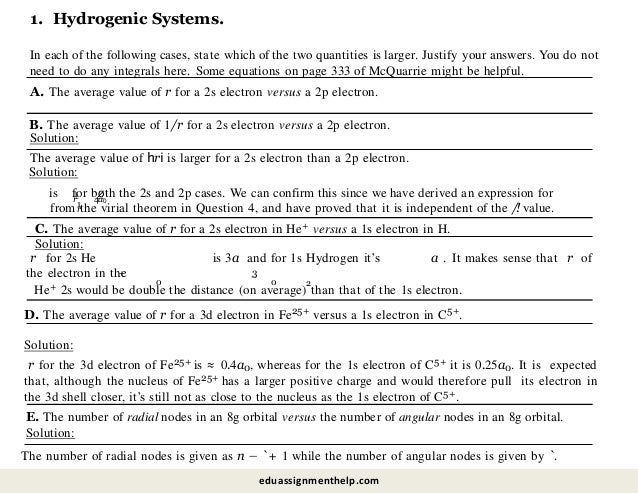
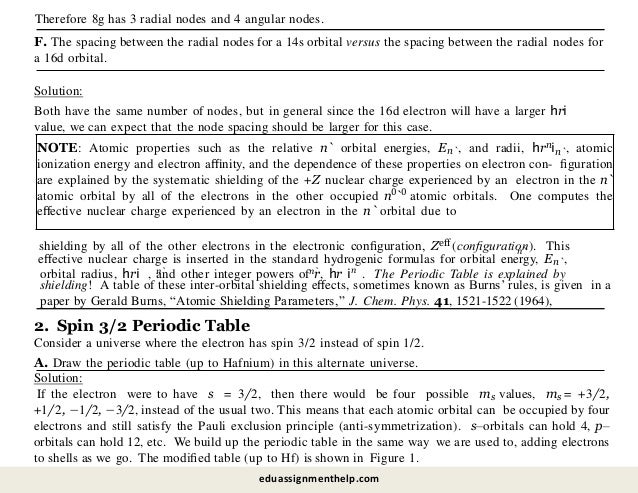
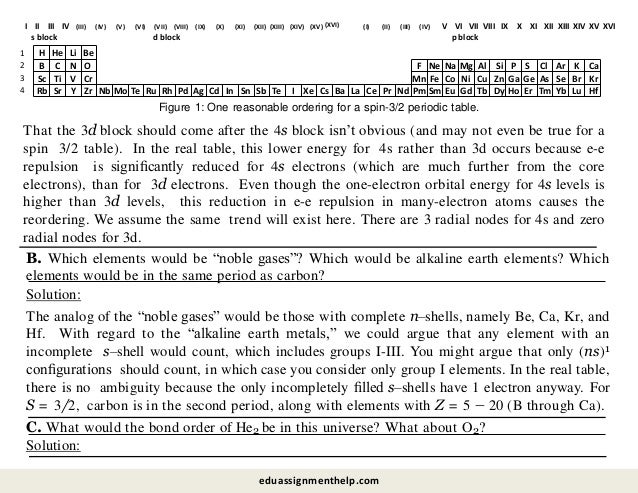
![Solution:
The octet rule is based on having complete n-shells. It should be clear that the simplest analog in the
spin 3/2 table is the “hexadectet” rule, i.e. n = 2 and 3 orbitals prefer to have 16 electrons in their outer
shells (4 in s and 12 in p).
important the electron’s spin is in determining the chemical structure and patterns of the universe.
D. What would the equivalent of the octet rule be in this alternate universe?
[NOTE: you could spend a lot of time answering this last question. It is intended to be fun. When it
stops being fun, your answer is long enough.]
Since each MO can also be filled with 4 electrons now, the bond order of He2 would be 4(!). O2, on
the other hand, now has a bond order of 0 (the two σ and two σ∗ orbitals from the O 1s and 2s
orbitals are each completely filled with 16 electrons). You should be realizing just how
eduassignmenthelp.com](https://image.slidesharecdn.com/eduassignmenthelp-220110111218/95/Physical-Chemistry-Homework-Help-5-638.jpg)
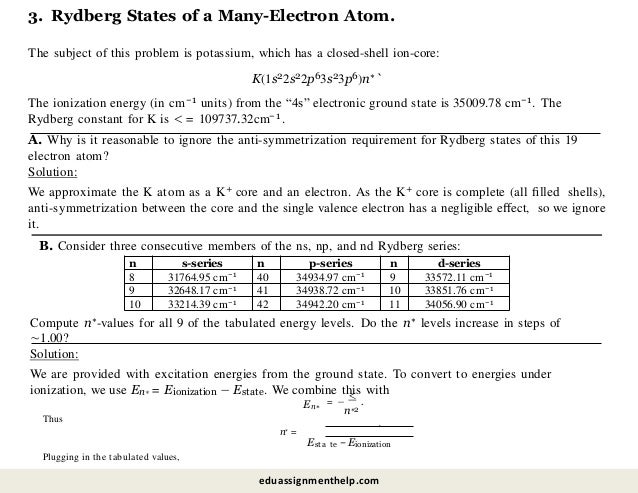
![C. The quantum defects, δ`, are defined as n − n∗. Compute the approximately n-independent
quantum defects for the s, p, and d series of K.
Solution:
See above table. δ` = n − n∗. We see that the defect for ns is about 2.2, for np is about 1.7, and for nd
is about 0.3.
D. Suggest a reason why δs » δp > δd.
Solution:
s orbitals penetrate further into the inner core than orbitals with higher angular momentum. From this
we expect δs » δp » δd ≈ 0.
4. Two Electron Wavefunctions: Spin.
For two electrons, the total z component of the spin angular momentum for the system is
while the total spin operator is given by
E. The n∗ values you have determined from real spectroscopic data may be considered “experi- mentally
measured.” But the tabulated integer n quantum numbers are not measured. They are inferred from
some sort of physical argument. Can you suggest what this argument is?
[HINT: the lowest s, p, and d states of K are called 4s, 4p, and 3d.]
Solution:
The quantum defects above are correct, even down to the 4s, 4p, and 4d states, to within 0.1. We don’t
record n∗ because, to an excellent approximation, it increases in steps of 1.
ns n* δs np n* δp ns n* δs
8 5.815 2.185 40 38.300 1.700 9 8.737 0.263
9 6.817 2.183 41 39.297 1.703 10 9.735 0.265
10 7.818 2.182 42 40.297 1.703 11 10.731 0.269
eduassignmenthelp.com](https://image.slidesharecdn.com/eduassignmenthelp-220110111218/95/Physical-Chemistry-Homework-Help-7-638.jpg)
![A. Show that both
αβ
1
ψ = √
2
1sα(1)
1sα(2)
2sβ(1)
2sβ(2)
1
2
≡ √ (2sα(1)2sβ(2) −2sβ(1)1sα(2))
and
βα
1
ψ = √
2
1sβ(1)
1sβ(2)
2sα(1)
2sα(2)
1
2
≡ √ (1sβ(1)2sα(2) −2sα(1)1sβ(2))
are antisymmetric.
Show also that ψαβ and ψβα are eigenfunctions of Sz, total. What are the eigenvalues in each case?
Solution: 1
Ψαβ = √
2
[1sα(1)2sβ(2) −2sβ(1)1sα(2)]
switching 1 and 2 by the Pˆ12 permutation operator
1
ˆ
P Ψ
12 αβ
2
= √ [1sα(2)2sβ(1) −2sβ(2)1sα(1)]
1
= −√
2
[2sβ(2)1sα(1) −1sβ(1)1sα(2)]
= −Ψαβ.
This indicates that Ψαβ is anti-symmetric:
1
Ψβα = √
2
[1sβ(1)2sα(2) −2sα(1)1sβ(2)]
switching 1 and 2 by Pˆ12
ˆ
P Ψ
12 βα
1
= √
2
[1sβ(2)2sα(1) −2sα(2)1sβ(1)]
1
= −√
2
[2sα(2)1sβ(1) −1sβ(2)2sα(1)]= −Ψβα.
This indicates that Ψβα is anti-symmetric. Now the eigenvalue for Ψαβ :
Sz, total = Sz1 + Sz2
z1 z2 αβ
S
z, total αβ
Ψ = S + S Ψ
1
= √
2
Sz1{1sα(1)2sβ(2) −2sβ(1)1sα(2)} + Sz2{1sα(1)2sβ(2) −2sβ(1)1sα(2)}
l
1
2
1sα(1)2sβ(2) − −
2
2sβ(1)1sα(2)
= √
2
2
+ − 1sα(1)2sβ(2) − 2 2sβ(1)1sα(2)
= 0
eduassignmenthelp.com](https://image.slidesharecdn.com/eduassignmenthelp-220110111218/95/Physical-Chemistry-Homework-Help-8-638.jpg)
![Sz, total βα
Now the eigenvalue for Ψβα:
Ψ = S + S Ψ
z1 z2 βα
1
= √
2
Sz1{1sβ(1)2sα(2) −2sα(1)1sβ(2)} + Sz2{1sβ(1)2sα(2) −2sα(1)1sβ(2)}
l
1
2
= √
2
−
2
1sβ(1)2sα(2) − 2sα(1)1sβ(2)
+
2 2
{1sβ(1)2sα(2) − − 2sα(1)1sβ(2)
= 0
This indicates that both Ψαβ and Ψβα are eigenfunctions of Sz, total, both with eigenvalues of 0.
B. Show that, while ψαβ and ψβα cannot be written in the form ψspaceψspin, the combinations of
ψαβ ± ψβα can both be cast in the form ψspaceψspin.
Solution:
1
1
Ψαβ = √
2
[1sα(1)2sβ(2) −2sβ(1)1sα(2)]
= √
2
[(1s(1)2s(2)α(1)β(2)) −(2s(1)1s(2)β(1)α(2))]
/= ΨspinΨspace
1
1
Ψβα = √
2
[1sβ(1)2sα(2) −2sα(1)1sβ(2)]
= √
2
[(1s(1)2s(2)β(1)α(2)) −(2s(1)1s(2)α(1)β(2))]
/= ΨspinΨspace.
However
1
1
Ψαβ + Ψβα = √
2
[1sα(1)2sβ(2) −2sβ(1)1sα(2) + 1sβ(1)2sα(2) −2sα(1)1sβ(2)]
= √
2
[{1s(1)2s(2)α(1)β(2)} −{2s(1)1s(2)β(1)α(2)}
+ {1s(1)2s(2)β(1)α(2)} −{2s(1)1s(2)α(1)β(2)}]
1
1
= √
2
{1s(1)2s(2) −2s(1)1s(2)}{α(1)β(2) + β(1)α(2)}
= √
2
Ψspace · Ψspin.
eduassignmenthelp.com](https://image.slidesharecdn.com/eduassignmenthelp-220110111218/95/Physical-Chemistry-Homework-Help-9-638.jpg)
![Similarly,
1
1
Ψαβ −Ψβα = √
2
[1sα(1)2sβ(2) −2sβ(1)1sα(2) −1sβ(1)2sα(2) + 2sα(1)1sβ(2)]
= √
2
[{1s(1)2s(2)α(1)β(2)} −{2s(1)1s(2)β(1)α(2)}
—
{1s(1)2s(2)β(1)α(2)} + {2s(1)1s(2)α(1)β(2)}]
1
1
= √
2
{1s(1)2s(2) + 2s(1)1s(2)}{α(1)β(2) −β(1)α(2)}
= √
2
Ψspace · Ψspin.
C. Verify that the total spin operator can be re-written in terms of raising and lowering operators:
S
total 1
2 2
2
2
= S + S + 2S S z z
1 2 + S1+ S2− + S1− S2+ .
Solution:
S 2
total 1 2 1 2 1
2
1 2 2 1
= (S + S )(S + S ) = S + S S + S S + S 2
2
1
1
2
2
1 2
= S + S + 2(S S )
1
2
2
2
I (
1 2
x x y y z z
1 2 1 2
= S + S + 2(S S + S S + S S )
1 2
2 2
z1 z2
= S + S + 2S S + 2
S + S S + S
+1 − 1 +2 − 2
2 2
(
+
S
2i
—
S S −S
+1 − 1 +2 − 2
2i
l
1
2
2
2
z1 z2
1
2
= S + S + 2S S + S S S S
+ S + S S + S S −S + S S
+1 +2 +1 −2 − 1 +2 − 1 −2 +1 +2 +1 −2
+S S −S S
− 1 +2 − 1 −2
l
1 2
2 2
z z
1 2
= S + S + 2S S + (S+ 1 S− 2 + S− 1 S+2)
eduassignmenthelp.com](https://image.slidesharecdn.com/eduassignmenthelp-220110111218/95/Physical-Chemistry-Homework-Help-10-638.jpg)
![total
D. Show that neither ψ nor
ψ
αβ βα
is an eigenfunction of S . That is to say, show that neither
2
of these wavefunctions is a total spin eigenstate.
Solution:
2
total
S Ψ αβ
2
1 2
2
= S + S + 2S S z z
1 2
l
+ S S + S S Ψ
+1 − 2 − 1 +2 αβ
2
S Ψ
1 αβ
3
4
2
= Ψ S 2 3
4
αβ 2 αβ
2
Ψ = Ψ αβ
2
2Sz1Sz2Ψαβ = √
2
Sz1 −
2
1sα(1)2sβ(2) −
2
2sβ(1)1sα(2)
= −√
2 2
1sα(1)2sβ(2) + −
2
2sβ(1)1sα(2)
2
= −
2
Ψαβ
1
S+ 1 S− 2Ψαβ = √
2
S+1
I
3 1
0 −
4
+
4
2sβ(1)1sβ(2)
l
3 1
2
= −√
2
·
4
+
4
2sα(1)1sβ(2)
= −√
2
2sα(1)1sβ(2)
S− 1 S+2Ψαβ = √
2
S− 1
I
1 3 1
4
+
4
1sα(1)2sα(2) + 0
l
2
= √
2
· 1sβ(1)2sα(2)
= √
2
1sβ(1)2sα(2)
Therefore, summing over all the terms gives
2
total
S Ψ αβ
2
= Ψ αβ
2
2
+ √ [1sβ(1)2sα(2) −2sα(1)1sβ(2)]
= 2[Ψαβ + Ψβα]
Repeating similar steps for Ψβα gives
total
2
total
S Ψβα = 2[Ψαβ + Ψβα].
Therefore, neither Ψαβ nor Ψβα 2
is an eigenfunction of S
.
eduassignmenthelp.com](https://image.slidesharecdn.com/eduassignmenthelp-220110111218/95/Physical-Chemistry-Homework-Help-11-638.jpg)
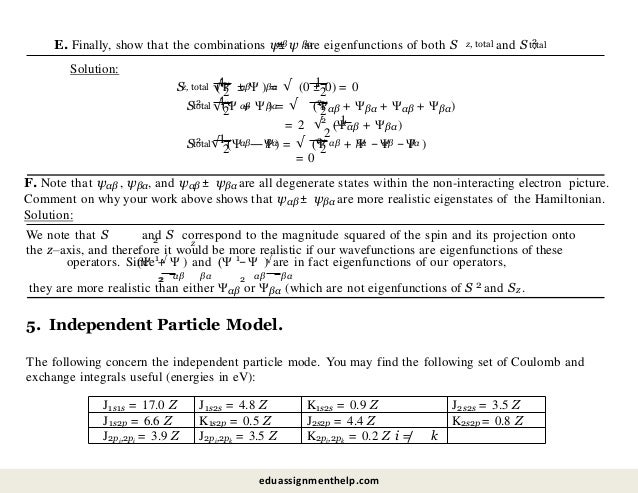
![A. Using the independent particle model discussed in class, what is the energy difference between the
1s2px2 configuration and the 1s22s2 configuration? How do you justify your result?
Solution:
We are asked to calculate the enregy difference between a 1s22p2 and a 1s22s2 configuration. Let’s
x
compute the energy for each using the independent particle model
2 2
x
E[1s 2p ] =
E
i
i>j
+ J −K
ij ij
i i,j
= 2E1s + 2E2p
+ J1sα,1sβ + J1sα,2px α + J1sα,2px β + J1sβ,2px α + J1sβ,2px β + J2px α,2px β
—K —K −K —K −K −K
x x x x x x
1sα,1sβ 1sα,2p α 1sα,2p β 1sβ,2p α 1sβ,2p β 2p α,2p β
= 2E1s + 2E2p + J1s,1s + 4J1s,2p + J2pi,2pi −2K1s,2p
E[1s22s2] = 2E1s + 2E2s + J1s,1s + 4J1s,2s + J2s,2s −2K1s,2s
(5.1)
(5.2)
⇒ ∆E = 4(J1s,2p −J1s,2s) + (J2pi,2pi −J2s,2s) −2(K1s,2p −K1s,2s)
= Z[4(6.6 −4.8) −(3.9 −3.5) −2(0.5 −0.9)]
= +7.6Z eV (5.3)
B. What is the energy difference between the ground state of Lithium and the spin polarized
1s↑2s↑2pz↑ state? Is this energy about the size you expected?
Solution: E[1s22s1] = 2E1s + E2s + J1s1s + 2J1s2s −K1s2s
= −
2
2
Z 2 1
12
+
22(27.2 eV ) + Z(17.0 + 2 · 4.8 −0.9)
2
= −3 (9/8)(27.2) + 3(25.7) = −198.3 eV (5.4)
E[1s↑2s↑2p↑
x] = E1s + E2s + E2p + J1s2s + J1s2p + J2s2p −K1s2s −K1s2p −K2s2p
Z
= −
2
2
1 2
12
+
22
(27.2 eV ) + Z(4.8 + 6.6 + 4.4 −0.9 −0.5 −0.8)
2
= −3 (3/4)(27.2) + 3(13.6) = −142.8 eV
⇒ ∆E = −142.8 + 198.3 = 55.5 eV
(5.5)
(5.6)
Consulting the NIST Atomic Spectra Database [physics.nist.gov/cgi-bin/ASD], we find that the high-spin
1s2s2p state lies 57.469 eV above the ground state. Our IPM prediction is remarkably close given we’ve
only included first order e-e repulsion corrections!
eduassignmenthelp.com](https://image.slidesharecdn.com/eduassignmenthelp-220110111218/95/Physical-Chemistry-Homework-Help-13-638.jpg)
![C. Use the IPM To compute the ionization potential of B (Boron): IP = E(B+) − E(B). Compare your
boron result with the ionization potential of Lithium within the IPM. Does this agree with periodic
trends?
Solution:
No solution given.
D. Finally, compare the ionization potentials computed in part C. with the experimental results [IP(Li) =
5.4eV, IP(B) = 8.3eV] and the answer you would have gotten if you had assumed that the electrons do
not interact.
Solution:
First, we calculate the ionization energy of Be:
2 2
E[Be → 1s 2s ] = 2E1s + 2E2s + J1s1s + 4J1s2s + J2s2s −2K1s2s
= −
2
2
Z 2 2
12
+
22
(27.2 eV ) + Z(17.0 + 4 × 4.8 + 3.5 −2 × 0.9)
2
= −4 (5/4)(27.2) + 4(37.9) = −392.4 eV (5.7)
E[Be+ → 1s22s] = 2E1s + E2s + J1s1s + 2J1s2s −K1s2s
= −
2
2
Z 2 2
12
+
22(27.2 eV ) + Z(17.0 + 2 × 4.8 −0.9)
2
= −4 (9/8)(27.2) + 4(25.7) = −386.8 eV
⇒ IE = ∆E = −386.8 + 392.4 = 5.6 eV
(5.8)
(5.9)
Now, we do the same for Li. Note the ground state for Li is the same as Be+ with Z = 4 → Z = 3.
E[Li → 1s22s] = −32(9/8)(27.2) + 3(25.7) = −198.3 eV (5.10)
E[Li+ → 1s2] = 2E1s + J1s1s
= −
2
2
Z 2
12
(27.2 eV ) + Z(17.0) = −193.8 eV (5.11)
⇒ IE = ∆E = −193.8 + 198.3 = 4.5 eV (5.12)
The experimental IEs for Be and Li are 9.32 and 5.39 eV, respectively (NIST ASD). Though the IPM
values are significantly off in magnitude, they reproduce the correct periodic trend: elements in the same
period have increasing IEs from left to right.
In the absence of e-e interactions, the IEs would be the energies of the vacated one-electron orbitals. In
each case this is a 2s orbital. The energy for Be would be 42/2(22) × 27.2 = 54.4 eV and for Li,
eduassignmenthelp.com](https://image.slidesharecdn.com/eduassignmenthelp-220110111218/95/Physical-Chemistry-Homework-Help-14-638.jpg)
![32/2(22) × 27.2 = 30.6 eV. These values are extremely high! Even though the IPM predictions are not
quantitatively correct, we see that they do account for the majority of the effects caused by e-e interactions.
x
E. Within the IPM, what is the energy difference between a closed shell 1s22s22p2 configuration
and a high spin 1s22s↑2p↑
x2p↑
y2p↑
z configuration for carbon? Does this agree with your intuition?
Solution:
Our final problem is comparing closed-shell and high-spin configurations for carbon,
Z = 6. x
E[1s22s22p2] = 2E1s + 2E2s + 2E2p
+ J1s1s + 4J1s2s + 4J1s2p + J2s2s + 4J2s2p + J2px2px
= −
2
2
—2K1s2s −2K1s2p −2K2s2p
Z 2 4
12
+
22 (27.2 eV ) + Z(83.2)
= 969.6 eV (5.13)
E[1s22s↑2p↑
x2p↑
y2pz
↑] = 2E1s + 1E2s + 3E2p
+ J1s1s + 2J1s2s + 6J1s2p + 3J2s2p + 3J2pi2pk
2
+ K1s2s −3K1s2p −3K2s2p −3K2pi 2pk
= −
2
Z 2 4
12
+
22 (27.2 eV ) + Z(84.5)
= −961.8 eV (5.14)
⇒ E[high spin] −E[closed shell] = ∆E = 7.8 eV. (5.15)
This agrees with our chemical intuition, where we expect closed shell configurations to be the most stable.
eduassignmenthelp.com](https://image.slidesharecdn.com/eduassignmenthelp-220110111218/95/Physical-Chemistry-Homework-Help-15-638.jpg)